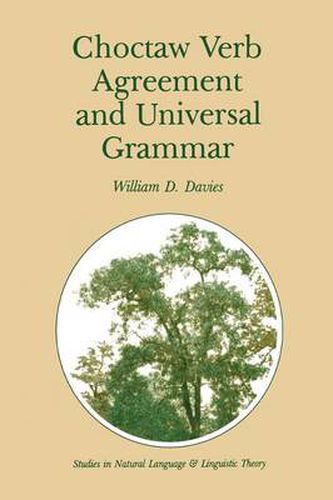Readings Newsletter
Become a Readings Member to make your shopping experience even easier.
Sign in or sign up for free!
You’re not far away from qualifying for FREE standard shipping within Australia
You’ve qualified for FREE standard shipping within Australia
The cart is loading…






This title is printed to order. This book may have been self-published. If so, we cannot guarantee the quality of the content. In the main most books will have gone through the editing process however some may not. We therefore suggest that you be aware of this before ordering this book. If in doubt check either the author or publisher’s details as we are unable to accept any returns unless they are faulty. Please contact us if you have any questions.
The Choctaw language, indigenous to the southeastern United States, now with its greatest concentrations ofspeakers in Missis- sippi, Oklahoma, and Los Angeles, has in the main escaped the scrutinyoftheoreticallinguistics.ItisnotthatChoctaw isanintrin- sicallyuninterestinglanguage- aquickglanceataclausewithfive agreement controllers and a mismatch between the caseofafree- standingnominaland its agreement affix should dispelthat notion. Rather it is, I think, the question of what we can learn from a languageinwhichNPsdon'tmovearound, WHs don'tfront, and gaps simply arise from pronominalization. My hope is that the presentvolume,takentogetherwithagrowingliteraturespurredon by the workofPamMunro and her students atUCLA, will bring Choctawintothelightofdayand into the circleoflanguagescon- sidered when constructing theories that define possible human language . Thepresentstudy,arevisionofmy 1981dissertation(University ofCalifornia,SanDiego),focusesfirstandforemostontheChoctaw agreementsystem,takingthisasthekeytothestructureofChoctaw syntax. The immediate goal, then, is to provide a unified account ofthestructures and rules underlyingtheagreement system.Along the way a rangeofgrammatical phenomena is examined, taken as evidence for particular structural configurations, and incorporated into awell-integratedaccountofmorphologicaland syntacticfacts. The resultsbearon anumber ofcurrent issues, includingthe Un- accusative Hypothesis, the existence of demotions, the nature of antipassive, disjunctive rule application, universals of causative constructions, and others.For these reasons Choctawdeserves the scrutinyoftheoreticians. The data forming the corpus for analysis represent a variety of Oklahoma Choctaw.They were collected from a nativespeaker in San Diego between 1978 and 1982 and from various speakers in Oklahoma during two extended visits to Broken Bow in 1980. I lX PREFACE x wishtothankthespeakerswhohelpedmebysharingtheirlanguage andencouragingmystudies.MyworkonChoctawwassupportedin partbyfundsfrom theNationalScienceFoundation(throughgrant numberBNS78-17498totheUniversityofCalifornia,SanDiego), theAmericanPhilosophicalSociety(throughaPhillipsFundgrant), andtheDepartmentofLinguisticsatUCSD.
$9.00 standard shipping within Australia
FREE standard shipping within Australia for orders over $100.00
Express & International shipping calculated at checkout
This title is printed to order. This book may have been self-published. If so, we cannot guarantee the quality of the content. In the main most books will have gone through the editing process however some may not. We therefore suggest that you be aware of this before ordering this book. If in doubt check either the author or publisher’s details as we are unable to accept any returns unless they are faulty. Please contact us if you have any questions.
The Choctaw language, indigenous to the southeastern United States, now with its greatest concentrations ofspeakers in Missis- sippi, Oklahoma, and Los Angeles, has in the main escaped the scrutinyoftheoreticallinguistics.ItisnotthatChoctaw isanintrin- sicallyuninterestinglanguage- aquickglanceataclausewithfive agreement controllers and a mismatch between the caseofafree- standingnominaland its agreement affix should dispelthat notion. Rather it is, I think, the question of what we can learn from a languageinwhichNPsdon'tmovearound, WHs don'tfront, and gaps simply arise from pronominalization. My hope is that the presentvolume,takentogetherwithagrowingliteraturespurredon by the workofPamMunro and her students atUCLA, will bring Choctawintothelightofdayand into the circleoflanguagescon- sidered when constructing theories that define possible human language . Thepresentstudy,arevisionofmy 1981dissertation(University ofCalifornia,SanDiego),focusesfirstandforemostontheChoctaw agreementsystem,takingthisasthekeytothestructureofChoctaw syntax. The immediate goal, then, is to provide a unified account ofthestructures and rules underlyingtheagreement system.Along the way a rangeofgrammatical phenomena is examined, taken as evidence for particular structural configurations, and incorporated into awell-integratedaccountofmorphologicaland syntacticfacts. The resultsbearon anumber ofcurrent issues, includingthe Un- accusative Hypothesis, the existence of demotions, the nature of antipassive, disjunctive rule application, universals of causative constructions, and others.For these reasons Choctawdeserves the scrutinyoftheoreticians. The data forming the corpus for analysis represent a variety of Oklahoma Choctaw.They were collected from a nativespeaker in San Diego between 1978 and 1982 and from various speakers in Oklahoma during two extended visits to Broken Bow in 1980. I lX PREFACE x wishtothankthespeakerswhohelpedmebysharingtheirlanguage andencouragingmystudies.MyworkonChoctawwassupportedin partbyfundsfrom theNationalScienceFoundation(throughgrant numberBNS78-17498totheUniversityofCalifornia,SanDiego), theAmericanPhilosophicalSociety(throughaPhillipsFundgrant), andtheDepartmentofLinguisticsatUCSD.